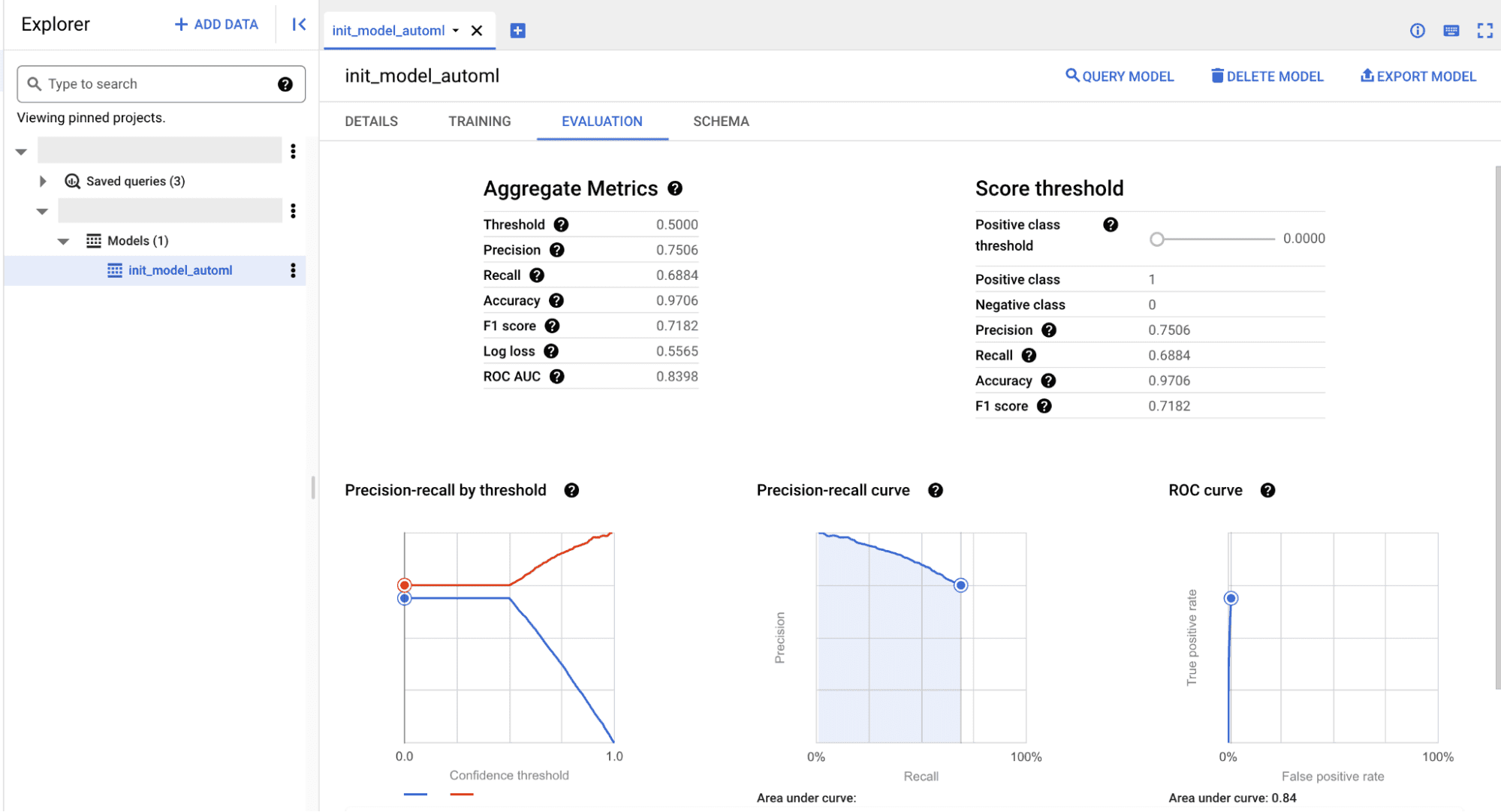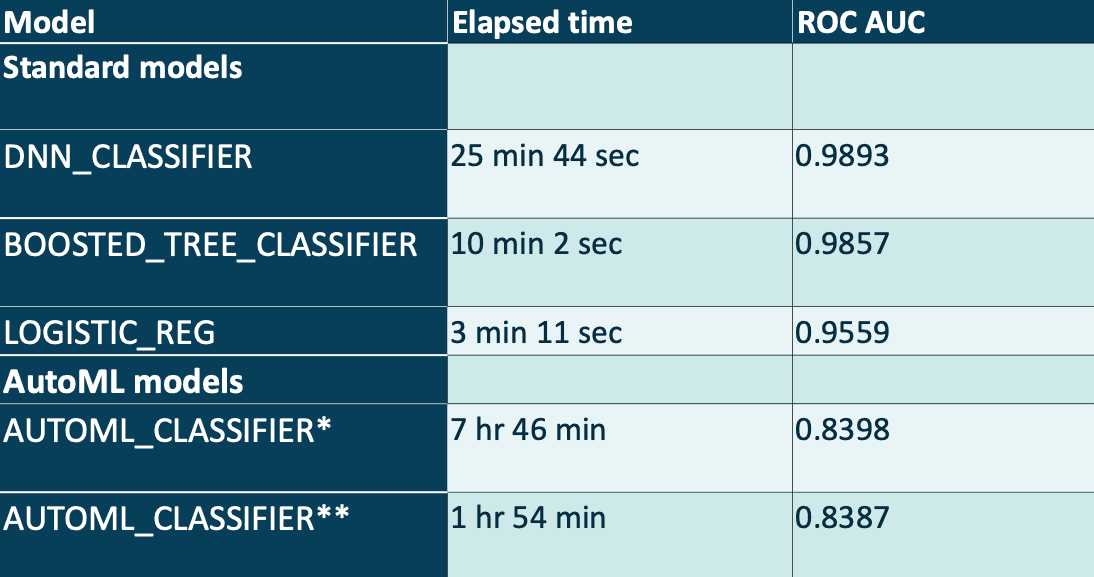DATA Pill – the blue pill that (accidentally) works!
Ever felt overwhelmed by the flood of news about the latest technologies, tools, and trends in Data, AI, and ML? A new framework here, a revolutionary…
Read moreMachine learning is becoming increasingly popular in many industries, from finance to marketing to healthcare. But let's face it, that doesn't mean ML will necessarily be a viable solution for every organization. Will the benefit-cost ratio be satisfactory? On the other hand, it would be reckless not to check out the possibilities of ML. Implementing machine learning is a huge process, generating big costs. In this article, we will present a solution that can be an easy start to a machine learning journey and can help you to validate whether ML will be an efficient solution to the problems that your organization is facing.
In this article, we’ll introduce AutoML models, followed by an example of the AutoML Classifier model trained in BigQuery ML. We will discuss AutoML's applicability, limitations and application examples.
Automated Machine Learning, also called AutoML, is an approach to lower the entry-level into Machine Learning. The main idea is to automate data preparation, feature engineering, model training and model evaluation. As a result, the end user gets a simplified interface to train machine learning models: the raw data as an input and the ready-to-use machine learning model as an output.
AutoML is available through multiple tools and frameworks (i.e., auto-sklearn, AutoKeras, tpot). Since the goal of AutoML is to lower the entry barrier for Machine Learning, in our example we’ll leverage the AutoML offered in the Google Cloud Platform as a part of BigQuery ML (BQML). With this serverless setup, we can leverage the AutoML without any complicated configuration and infrastructure maintenance.
Behind the scenes, Auto ML performs the regular Machine Learning workflow:

While this black-box approach is not a one-size-fits-all solution to every problem, you may find it helpful to:
However, even with the aforementioned limits, AutoML is still a good approach to start your journey with Machine Learning and check if it’s the right solution.
One of the most critical use cases of AutoML is supervised learning for structured data, including the features columns and the target column [source].
AutoML in BigQuery offers 2 model types: AutoML Classifier for classification problems and AutoML Regressor for regression problems.
In the following steps, we’ll use this scenario to demonstrate how AutoML Classifier (backed by AutoML Tables in Vertex AI) works in BigQuery. We’ll build a machine learning classification model to predict the probability of adding a product to a shopping cart by an e-commerce website user. The source dataset will be the Google Analytics 4 export to BigQuery (See: A Step-by-Step Guide to Training a Machine Learning Model using BigQueryML (BQML) - GetInData).
First, you need to prepare the source data (see: A Step-by-Step Guide to Training a Machine Learning Model using BigQueryML (BQML) - GetInData ) by running the following query:
Now you can create your first AutoML model in BigQuery with the following query:
CREATE OR REPLACE MODEL
bqmlhackathon.ga4.init_model_automl
OPTIONS(MODEL_TYPE = 'AUTOML_CLASSIFIER',
BUDGET_HOURS = 1.0,
INPUT_LABEL_COLS = ['addedToCart'],
OPTIMIZATION_OBJECTIVE = 'MAXIMIZE_AU_ROC'
)
AS
SELECT
*
FROM
`bqmlhackathon.ga4.ga4_sample_ecommerce`
;This is a minimal setup, where we only need to specify:
That’s all you need for the first model. AutoML will do the rest of the machine learning workflow (but it takes time).
When the model is ready, you can check its performance on the [Evaluation] tab. Since we’re trying to solve a classification problem, our evaluation metric will be ROC AUC (the higher value the better). Note, that it seems like the budget_hours limit breaks the training process and thus needs more time to complete.

In the table below, we compare standard machine learning models and AutoML models performance along with the training time. We measured the elapsed time to create a model on the same data, then measured the model performance using ROC AUC metric.

* BUDGET_HOURS = 4.0
** BUDGET_HOURS = 1.0
As you can see, the model trained by AUTOML_CLASSIFIER gets a high ROC AUC score, but not as high as other models created manually by the data scientists. The results of AutoML may be closer to the expert-created models when we use more training hours (and a higher budget) - the maximum BUDGET_HOURS is 72, but you should keep in mind that the cost of training may not be reasonable to the produced result.
1 TB of data processing for AutoML model training in BigQuery costs 5$ plus the Vertex AI training cost [[source]](https://cloud.google.com/bigquery-ml/pricing#bqml). For a more accurate estimate, you should add Vertex AI AutoML pricing - 21$ per 1 hour of training [source].
Be careful with the initial cost estimate visible in the BigQuery console - the preprocessing stage (see: Best practices for creating training data | AutoML Tables | Google Cloud) may explode the dataset size. Also, the preprocessed dataset can be accessed multiple times in parallel to create multiple models during the AutoML training process. This will highly impact the data processed during your BigQueryML training job. Also, the initial cost estimate doesn't seem to include the Vertex AI AutoML pricing.
In our test scenario, the initial estimate for 135 MB turned out to be 3.5 TB, billed for the 1 hour model training. The same training for 4 hours processed 26.69 TB of data.
If you want to hold control over the workflow, but still use AutoML models, you can try Tabular Workflows on Vertex AI, where you can enable/disable auto mode for each workflow step.

What can you do next with your AutoML model? The two standard ways are to get predictions on the new data within BigQuery, or export the model to use it outside the BigQuery environment (i.e. for online predictions serving in your application).
To get the predictions on the new data, BigQuery offers the ML.PREDICT function with the following syntax (See: The ML.PREDICT function | BigQuery ML | Google Cloud).
SELECT
sessionId,
prob as addedToCart
FROM
ML.PREDICT(MODEL `bqmlhackathon.ga4.init_model_logistic_reg`,
(
SELECT *,CONCAT(fullVisitorId, CAST(visitStartTime as string)) as sessionId
FROM `bqmlhackathon.ga4.ga4_sample_ecommerce_20201231`)
),
UNNEST(predicted_addedToCart_probs)
WHERE label = 1You can export your AutoML for use out of BigQuery:
Exporting models | BigQuery ML | Google Cloud
The model export will produce the model artifact in the TensorFlow SavedModel format.
Unfortunately, online serving of AutoML models is not supported in the Vertex AI Endpoints (Exporting models | BigQuery ML | Google Cloud). The reason behind this is that the AutoML models require a custom Docker container for model serving, which is not included in the pre-built containers in VertexAI Endpoints (gcr.io/cloud-automl-tables-public/model_server).
You can still deploy the AutoML model on Vertex AI Endpoints by building the custom Docker container and storing it in the Artifact Registry. However, this scenario introduces an extra complexity which may not be balanced by the benefits of using AutoML.
As mentioned before, AutoML won’t be an ideal approach in every case, but it can be a good point to start the Machine Learning journey. Below you'll find a short list of complementary articles that can help you along the way.
Interested in ML and MLOps solutions? How to improve ML processes and scale project deliverability? Watch our MLOps demo and sign up for a free consultation.
Ever felt overwhelmed by the flood of news about the latest technologies, tools, and trends in Data, AI, and ML? A new framework here, a revolutionary…
Read moreIn this blog post, we will simply and clearly demonstrate the difference between 4 popular feature stores: Vertex AI Feature Store, FEAST, AWS…
Read moreIntroduction In the ever-evolving world of data analytics, businesses are continuously seeking innovative methods to unlock hidden value from their…
Read moreIntroduction - what are Flame Graphs? In Developer life there is a moment when the application that we create does not work as efficiently as we would…
Read moreRecently we published the first ebook in the area of MLOps: "Power Up Machine Learning Process. Build Feature Stores Faster - an Introduction to…
Read moreAt GetInData, we build elastic MLOps platforms to fit our customer’s needs. One of the key functionalities of the MLOps platform is the ability to…
Read moreTogether, we will select the best Big Data solutions for your organization and build a project that will have a real impact on your organization.
What did you find most impressive about GetInData?